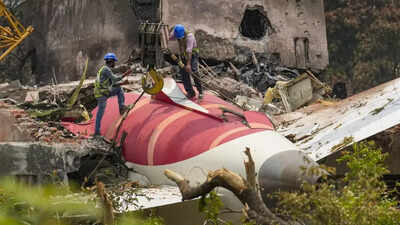Air India plane crash: Over a fortnight after the fatal Air India aircraft disaster that claimed lives of all onboard except for a single survivor, investigators alongside the airline are analysing the possibility of simultaneous engine failures that may have caused the Boeing 787 aircraft to lose altitude and crash.Air India pilots have conducted simulations of the ill-fated flight’s conditions in a simulator, testing scenarios with extended landing gear and retracted wing flaps. These simulations revealed that these configurations alone would not have resulted in a crash, according to sources close to the investigation quoted in a Bloomberg report.
These findings, coupled with the earlier detection of an emergency-power turbine activation moments before impact, have strengthened the investigation’s focus towards technical malfunction as a potential cause, sources said in the report.
Air India Plane Crash Simulation & Clues
- The cause of simultaneous power loss in both engines remains unclear, whilst investigators continue their analysis of data from the two flight recorders.
- Whilst the investigation considers various possibilities, technical matters have become a primary focus, according to sources familiar with the matter.
- The test flight simulation was performed independently of the formal investigation being conducted by India’s AAIB, with the purpose of examining potential circumstances, according to one source familiar with the matter.
- The ill-fated Boeing 787 that met with disaster in Ahmedabad on June 12 utilised two General Electric Co. manufactured engines.
- Visual recordings captured the aircraft’s unsuccessful attempt to achieve height post-takeoff, followed by its descent to the ground, finally leading to the crash.
- Aviation experts who studied the footage noted the forward tilt of the landing gear, indicating that the flight crew had begun retracting the wheels.
- The unopened landing-gear doors, combined with the gear position, suggests potential power loss or hydraulic system failure. This observation further strengthens the possibility of engine-related issues, as the engines supply the aircraft’s electrical power, the Bloomberg report said.
Computer-operated systems known as Full Authority Digital Engine Control (FADEC) regulate modern aircraft engines. This technology assists pilots in managing aircraft power while ensuring optimal engine performance within specified operational boundaries.Also Read | Air India plane crash: 787 Dreamliner is Boeing’s flagship product – 10 things to know about aircraft model involved in Ahmedabad crashPrevious investigations revealed that prior to the crash, the RAT (Ram Air Turbine), an emergency turbine located at the aircraft’s rear section, was deployed. Although this device supplies crucial electrical power during system failures, its small size prevents it from producing any aerodynamic lift.Examination of the debris indicates that the wing flaps and slats, crucial components for enhancing aircraft lift during takeoff, were in their proper extended position. This incident stands as the most severe in Indian civil aviation history over multiple decades, and represents the first catastrophic loss of a Boeing 787 Dreamliner. The flight crew, who did not survive the incident, issued a Mayday distress signal moments after becoming airborne. According to two sources close to the investigation, approximately 15 seconds elapsed between the emergency call and the aircraft’s impact. Representatives from Boeing and the US National Transportation Safety Board are present on site to assist with the investigative process.The timeline for authorities to release findings from the flight data recorders remains uncertain. These devices traditionally provide detailed information about aircraft configurations, operational parameters and flight deck communications.Also Read | Air India AI 171 plane crash in Ahmedabad: Flying has become safer over the decades; last 5 years safest since 2000







